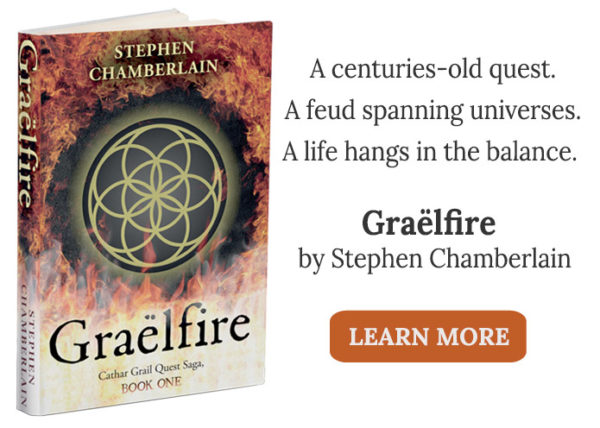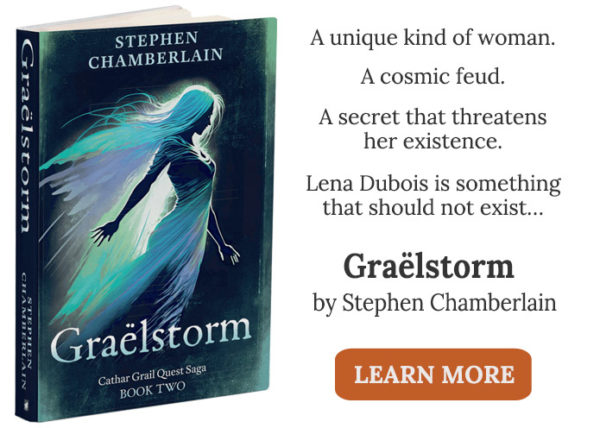“All the world’s a stage,
And all the men and women merely players;
They have their exits and their entrances,
And one man in his time plays many parts…”
– William Shakespeare
Everyone has a history. But when it comes to fiction, how much of a character’s past is relevant to their story? The answer is obvious: only what is interesting and relevant to the plot.
Backstory
In a recent piece titled “What Every Villain Needs,” I described how my mentor suggested adding the villain’s backstory to my novel Graëlfire:
“Why the need to rake over the past?” I asked.
“Because it sheds light on the rest of the story line,” she said. “Your heroine and villain are linked. His past is integral to her present — it continues to impact her. Unless you tell his backstory, you won’t do your villain or story line justice.”
Her point struck a chord. Who doesn’t love the tale of a good guy gone bad? A backstory would show his descent into villainy and let readers experience his journey. My quandary was how to deliver.
Two techniques from the writer’s toolkit sprang to mind: a prologue or a sequence of flashbacks. Both could showcase events from the character’s past, but I wasn’t comfortable using either. A prologue must be pithy; it could never make room for the chain of events that turn my villain into a badass. Besides, I’d set his backstory in the Middle Ages. Starting the story with a historical look-back would set the wrong tone to a present-day primary plot. Flashbacks were equally ill-suited. They, too, must be brief and used sparingly, or they slow the pace of a narrative.
My mentor agreed. The villain’s backstory was too long for either a prologue or flashbacks. Only a parallel plotline would do.
Dual Story Timelines
I took a deep breath. More than one timeline! That would mean alternating two stories side by side and asking readers to follow them in tandem. The pitfalls were obvious. How to make both stories equally compelling? How to flip between narratives set centuries apart without jarring the reader’s attention? How to blend them into a seamless novel?
“Ground your present-day story first,” my mentor advised. “Your readers will need to care about the present if they are to care for the past.”
The Three-Act Structure
Heeding her advice, I went back to my manuscript. Like most novels, it followed a format that’s been around for over a millennium: the classic three-act structure.
- Act 1 (setup): the first quarter of a novel introduces the characters, the hero’s call to adventure and the inciting incident that sends them on their quest.
- Act 2 (conflict): the central half of a story is where writers often launch subplots. It covers the next two-quarters of a novel and tells of the hero’s ongoing struggle toward the story goals. It ends when a hero has all but failed and is staring defeat in the face.
- Act 3 (resolution): the last quarter of the story hosts the plot’s climax and its resolution.
This arrangement provided the roadmap. My readers could enjoy an uninterrupted present-day plot until the end of act one, when the quest calls my heroine to action. The villain’s backstory would be introduced and completed over the course of act two, leaving act three to show the past catching up with the present, erupting in a final showdown. No matter that the present-day thread was the dominant arc. What mattered was that both threads stood their ground as stories in themselves, each with their own plot, conflicts and climaxes.
Weaving the Strands
I wrote the backstory first as a historical novella and then layered it into act two of the primary story. Once the villain’s backstory began, I alternated the dual story timelines every couple of chapters so readers could keep track of both as they switched back and forth.
The historical thread took me a year to write. It wasn’t so much the writing and editing. Fans of historical fiction are an unforgiving bunch. Events, sensory perceptions, characters and settings — all must be factual and accurate. There were Cathars and medieval places to research … scenes of persecution, torture, and execution to evoke — and all to be told through a medieval point of view. It was months before I put pen to paper.
Dual timelines are tricky, but worth the effort when they emerge as a single story. In my case, parallels between the past and present-day stories worked in my favour. They share the same quest goal. They have common characters and themes. Showing the past clues readers into what my heroine is up against in the here and now, giving them cause to root for her. I found other advantages, too. The pacing of a novel can seem a dark art. Alternating threads prolonged suspense as one arc interacted with the other.
Dual story timelines are not everyone’s cup of tea. And when writing gurus warn authors to beware of too much exposition, there’s reason to listen. But writing to rules can be formulaic, like a painting by numbers. My villain’s story arc lends a different tone to the book. It increases the drama, humanizes his character and portrays him as more bitter and tragic.
Dual story timelines were a perfect fit for Graëlfire. I hope you enjoy reading them as much as I did writing them.

Stephen Chamberlain is the author of the fantasy novel Graëlfire. He draws inspiration from the impact of landscape on myth, and the association of liminality with the supernatural and magic. Stephen lives in Switzerland.



